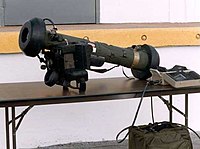
Photo from wikipedia
Abstract Three-dimensional thermal mapping from aerial images can be used in energy audits. Tie points that define the location of object points in a 3D space for reconstructing a 3D… Click to show full abstract
Abstract Three-dimensional thermal mapping from aerial images can be used in energy audits. Tie points that define the location of object points in a 3D space for reconstructing a 3D model, also include thermal information, which plays an important role in energy audits. However, it is often harder and less accurate to extract common features and determine tie points from low-resolution thermal images. It is more effective and accurate to use high-definition RGB images to determine tie points and fuse the RGB and thermal information. In this study, we investigate how to utilize high-definition RGB images that allow for more accurate tie point detection, how different flight configurations affect tie point data fusion, and how tie point data fusion performance can be improved. We propose a tie points' thermal and RGB data-fusion framework to create district-level thermal mapping to solve such problems. This paper aims to evaluate how different flight configurations affect the results of the proposed data fusion approach. Flight configurations include different camera altitudes (60 m and 35 m), distinct camera angles (45 degrees and 30 degrees), diverse flight path designs (mesh grid and Y path), and various building styles (campus buildings and city buildings). We find the following results in this paper: (1) higher flight altitude is not suggested for our data fusion approach; (2) a 30-degree thermal camera angle is suggested for roof inspection, while a 45-degree thermal camera angle is suggested for facade inspection when using the tie point data fusion approach; (3) a Y flight path performs better than a mesh grid path; and (4) our tie point data fusion approach performs better in traditional European city buildings than in modern campus buildings. We also demonstrate that pixels in the thermal images' central area can more accurately represent thermal information than pixels around the image edges for tie point data fusion. Additionally, our studies show that images taken at the edges of mapping areas have more errors. Thus, it is crucial to enlarge the survey area to obtain more accurate possible results.
Journal Title: Automation in Construction
Year Published: 2021
Link to full text (if available)
Share on Social Media: Sign Up to like & get
recommendations!